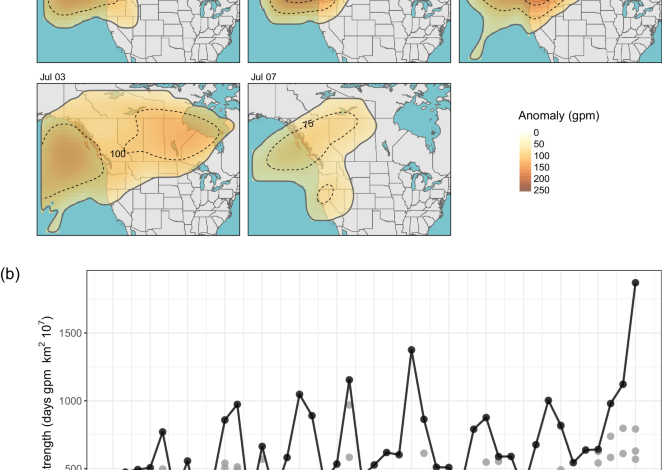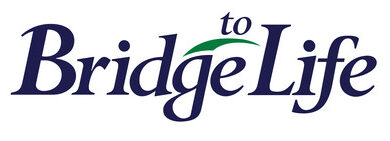Record-breaking fire weather in North America in 2021 was initiated by the Pacific northwest heat dome

White, R. H. et al. The unprecedented Pacific Northwest heatwave of June 2021. Nat. Commun. 14, 727 (2023).
BCCO report, Extreme Heat and Human Mortality: A Review of Heat-Related Deaths in B.C. in Summer 2021, British Columbia Coroners Office https://www2.gov.bc.ca/assets/gov/birth-adoption-death-marriage-and-divorce/deaths/coroners-service/death-review-panel/extreme_heat_death_review_panel_report.pdf, (accessed 2 September 2 2022).
Multnomah County, (2021). https://www.multco.us/multnomah-county/news/county-working-preliminary-report-june-2021-heat-wave-deaths-focusing-housing (Accessed 11 September 2022)
Washington State Department of Health, 2021. https://doh.wa.gov/emergencies/be-prepared-be-safe/severe-weather-and-natural-disasters/hot-weather-safety/heat-wave-2021 (Accessed 11 September 2022).
McKinnon, K. A. & Simpson, I. R. How unexpected was the 2021 Pacific Northwest heatwave? Geophys. Res. Lett. 49, e2022GL100380 (2022).
Thompson, V. et al. The 2021 western North America heat wave among the most extreme events ever recorded globally. Sci. Adv. 8, eabm6860 (2022).
Philip, S. Y. et al. Rapid attribution analysis of the extraordinary heatwave on the Pacific Coast of the US and Canada June 2021. Earth Syst. Dynam. 13, 1689–1713 (2022)
Wehrli, K. et al. The ExtremeX global climate model experiment: investigating thermodynamic and dynamic processes contributing to weather and climate extremes. Earth Syst. Dyn. 13, 1167–1196 (2022).
Kochtubajda, B. & Burrows, W. R. Cloud-to-Ground Lightning in Canada: 20 Years of CLDN Data. Atmos. Ocean 58, 316–332 (2020).
Schroeder, M. J. Critical fire weather patterns in the conterminous United States. Office of Meteorological Operations. Silver Spring, Maryland, USA (1969)
Flannigan, M. D. & Harrington, J. B. A study of the relation of meteorological variables to monthly provincial area burned by wildfires in Canada (1953–80). J. Appl. Meteor. 27, 441–452 (1988).
Skinner, W. R. et al. A 500 hPa synoptic wildland fire climatology for large Canadian forest fires, 1959–1996. Theor. Appl. Climatol. 71, 157–169 (2002).
Gedalof, Z. E., Peterson, D. L. & Mantua, N. J. Atmospheric, climatic, and ecological controls on extreme wildfire years in the northwestern United States. Ecol. Appl. 15, 154–174 (2005).
Zhong, S. et al. Synoptic weather patterns for large wildfires in the northwestern United States—a climatological analysis using three classification methods. Theor. Appl. Climatol. 141, 1057–1073 (2020).
Jain, P. & Flannigan, M. The relationship between the polar jet stream and extreme wildfire events in North America. J. Clim. 34, 6247–6265 (2021).
Hirsch, K. G. & Flannigan, M. D., November. Meteorological and fire behavior characteristics of the 1989 fire season in Manitoba, Canada. In Proceedings of International Conference on Forest Fire Research, Nov (pp. 19–22) (1990).
Sharma, A. R., Jain, P., Abatzoglou, J. T. & Flannigan, M. Persistent positive anomalies in geopotential heights promote wildfires in western North America. J. Clim. 35, 2867–2884 (2022).
Neal, E., Huang, C. S. & Nakamura, N. The 2021 Pacific Northwest heat wave and associated blocking: Meteorology and the role of an upstream cyclone as a diabatic source of wave activity. Geophys. Res. Lett. 49, e2021GL097699 (2022).
Osman, M., Zaitchik, B. F. & Winstead, N. S. Cascading drought‐heat dynamics during the 2021 Southwest United States Heatwave. Geophys. Res. Lett. 49, e2022GL099265 (2022).
Mo, R., Lin, H. & Vitart, F. An anomalous warm-season trans-Pacific atmospheric river linked to the 2021 western North America heatwave. Commun. Earth Environ. 3, 1–12 (2022).
Christidis, N. & Stott, P. A. Changes in the geopotential height at 500 hPa under the influence of external climatic forcings. Geophys. Res. Lett. 42, 10–798 (2015).
Dowdy, A. J., Mills, G. A., Finkele, K. & de Groot, W. Index sensitivity analysis applied to the Canadian forest fire weather index and the McArthur forest fire danger index. Meteorol. Appl. 17, 298–312 (2010).
Tymstra, C., Stocks, B. J., Cai, X. & Flannigan, M. D. Wildfire management in Canada: Review, challenges and opportunities. Prog. Disaster Sci. 5, 100045 (2020).
Abatzoglou, J. T., Juang, C. S., Williams, A. P., Kolden, C. A. & Westerling, A. L. Increasing synchronous fire danger in forests of the western United States. Geophys. Res. Lett. 48, e2020GL091377 (2021).
Taylor, S. W. Atmospheric cascades shape wildfire activity and fire management decision spaces across scales− A conceptual framework for fire prediction. Front. Environ. Sci. 8, 527278 (2020).
Bloem, S., Cullen, A. C., Mearns, L. O. & Abatzoglou, J. T. The role of international resource sharing arrangements in managing fire in the face of climate change. Fire 5, 88 (2022).
Matz, C. J. et al. Health impact analysis of PM2. 5 from wildfire smoke in Canada (2013–2015, 2017–2018). Sci. Total Environ. 725, 138506 (2020).
Canadian Forest Service, 2022. Canadian Wildland Fire Evacuation Database. Natural Resources Canada, Canadian Forest Service, Northern Forestry Centre, Edmonton, Alberta. Manuscript in preparation. (Accessed 26 April 2022).
Jain, P., Castellanos-Acuna, D., Coogan, S. C., Abatzoglou, J. T. & Flannigan, M. D. Observed increases in extreme fire weather driven by atmospheric humidity and temperature. Nat. Clim. Change 12, 63–70 (2022).
Ellis, T. M., Bowman, D. M., Jain, P., Flannigan, M. D. & Williamson, G. J. Global increase in wildfire risk due to climate‐driven declines in fuel moisture. Glob. Change Biol. 28, 1544–1559 (2022).
Francis, J. A. & Vavrus, S. J., Evidence linking Arctic amplification to extreme weather in mid‐latitudes. Geophys. Res. Lett. 39, L06801 (2012).
Francis, J. A. & Vavrus, S. J. Evidence for a wavier jet stream in response to rapid Arctic warming. Environ. Res. Lett. 10, 014005 (2015).
Mann, M. E. et al. Influence of anthropogenic climate change on planetary wave resonance and extreme weather events. Sci. Rep. 7, 1–12 (2017).
Blackport, R. & Screen, J. A. Insignificant effect of Arctic amplification on the amplitude of midlatitude atmospheric waves. Sci. Adv. 6, eaay2880 (2020).
Dai, A. & Song, M. Little influence of Arctic amplification on mid-latitude climate. Nat. Clim. Change 10, 231–237 (2020).
Abatzoglou, J. T. & Williams, A. P. Impact of anthropogenic climate change on wildfire across western US forests. Proc. Natl Acad. Sci. 113, 11770–11775 (2016).
Burke, M. et al. The changing risk and burden of wildfire in the United States. Proc. Natl Acad. Sci. 118, e2011048118 (2021).
Hersbach, H. et al. ERA5 hourly data on pressure levels from 1959 to present. Copernicus Climate Change Service (C3S) Climate Data Store (CDS). https://doi.org/10.24381/cds.bd0915c6 (2018b). (Accessed 20 Sept 2022).
Dole, R. M. & Gordon, N. D. Persistent anomalies of the extratropical Northern Hemisphere wintertime circulation: Geographical distribution and regional persistence character- istics. Mon. Weather Rev. 111, 1567–1586 (1983).
Miller, R. L., Lackmann, G. M. & Robinson, W. A. A new variable-threshold persistent anomaly index: Northern Hemisphere anomalies in the ERA-Interim reanalysis. Mon. Weather Rev. 148, 43–62 (2020).
Renwick, J. A. Persistent positive anomalies in the Southern Hemisphere circulation. Mon. Weather Rev. 133, 977–988 (2005).
Gibson, P. B. et al. Ridging associated with drought across the western and southwestern United States: Characteristics, trends, and predictability sources. J. Clim. 33, 2485–2508 (2020).
Parsons, S., Renwick, J. A. & McDonald, A. J. An assessment of future Southern Hemisphere blocking using CMIP5 projections from four GCMs. J. Clim. 29, 7599–7611 (2016).
Diffenbaugh, N. S. Verification of extreme event attribution: Using out-of-sample observations to assess changes in probabilities of unprecedented events. Sci. Adv. 6, eaay2368 (2020).
Swain, D. L., Singh, D., Touma, D. & Diffenbaugh, N. S. Attributing extreme events to climate change: a new frontier in a warming world. One Earth 2, 522–527 (2020).
Hall, R. J. et al. Generating annual estimates of forest fire disturbance in Canada: the National Burned Area Composite. Int. J. Wildland Fire 29, 878–891 (2020).
Eidenshink, J. et al. A project for monitoring trends in burn severity. Fire Ecol. 3, 3–21 (2007).
Van Wagner, C. E. Development and Structure of the Canadian Fire Weather Index System. Forestry Technical Report Vol. 35 (Canadian Forestry Service Headquarters, Ottawa, 1987).
Lawson, B. D. & Armitage, O. B. Weather guide for the Canadian forest fire danger rating system. (Canadian Forest Service, 2008).
Sedano, F. & Randerson, J. T. Vapor pressure deficit controls on fire ignition and fire spread in boreal forest ecosystems. Biogeosciences 11, 1309–1353 (2014).
Williams, A. P. et al. Correlations between components of the water balance and burned area reveal new insights for predicting forest fire area in the southwest United States. Int. J. Wildland Fire 24, 14–26 (2014).
Hersbach, H. et al. ERA5 hourly data on single levels from 1959 to present. Copernicus Climate Change Service (C3S) Climate Data Store (CDS). https://doi.org/10.24381/cds.adbb2d47 (2018a). (Accessed 20 Sept 2022).
Alduchov, O. A. & Eskridge, R. E. Improved Magnus form approximation of saturation vapor pressure. J. Appl. Meteorol. 35, 601–609 (1996).
McElhinny, M., Beckers, J. F., Hanes, C., Flannigan, M. & Jain, P. A high-resolution reanalysis of global fire weather from 1979 to 2018–overwintering the Drought Code. Earth Syst. Sci. Data 12, 1823–1833 (2020).
Van Wagner, C. E. A Method of Computing Fine Fuel Moisture Content Throughout the Diurnal Cycle Information Report PS-X-69 (Canadian Forestry Service, 1977). https://www.nature.com/articles/s41586-024-07028-5.
De Frenne, P. et al. Forest microclimates and climate change: Importance, drivers and future research agenda. Glob. Change Biol. 27, 2279–2297 (2021).
Wang, X. et al. cffdrs: an R package for the Canadian Forest Fire Danger Rating System. Ecol. Process 6, 5 (2017).
Magnussen, S. & Taylor, S. W. Inter-and intra-annual profiles of fire regimes in the managed forests of Canada and implications for resource sharing. Int. J. Wildland Fire 21, 328–341 (2012).
Hansen, M., Song, X. Vegetation Continuous Fields (VCF) Yearly Global 0.05 Deg [Data set]. NASA EOSDIS Land Processes DAAC. https://doi.org/10.5067/MEaSUREs/VCF/VCF5KYR.001 (2018) Accessed 8 June 2023.
Youssouf, H. et al. Quantifying wildfires exposure for investigating health-related effects. Atmos. Environ. 97, 239–251 (2014).
Gupta, P., Remer, L. A., Patadia, F., Levy, R. C. & Christopher, S. A. High-resolution gridded level 3 aerosol optical depth data from modis. Remote Sensing 12, 2847 (2020).
Krstic, N. & Henderson, S. B. Use of MODIS data to assess atmospheric aerosol before, during, and after community evacuations related to wildfire smoke. Remote Sens. Environ. 166, 1–7 (2015).
Center for International Earth Science Information Network – CIESIN – Columbia University. Gridded Population of the World, Version 4.11 (GPWv4): Population Count, Revision 11. Palisades, NY: NASA Socioeconomic Data and Applications Center (SEDAC). https://doi.org/10.7927/H4JW8BX5 (2018). (Accessed 5 April 2022).
Randles, C. A. et al. The MERRA-2 aerosol reanalysis, 1980 onward. Part I: System description and data assimilation evaluation. J. Clim. 30, 6823–6850 (2017).




